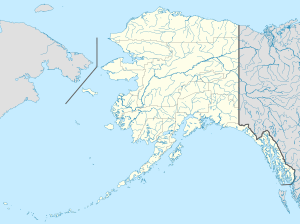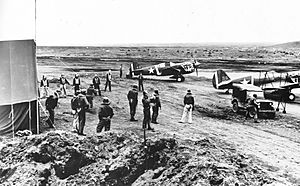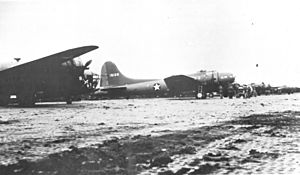Fort Glenn Army Air Base facts for kids
Quick facts for kids Cape Air Force BaseFort Glenn Army Airfield Cape Field at Fort Glenn |
|
|---|---|
| Part of Eleventh Air Force | |
| Umnak, Alaska | |
| Coordinates | 53°22′39″N 167°53′24″W / 53.37750°N 167.89000°W |
| Type | Military Airbase |
| Site information | |
| Controlled by | |
| Site history | |
| In use | 1942-1950 |
| Battles/wars | Aleutian Islands campaign |
Cape Air Force Base, also called Fort Glenn Army Air Base, was a very important military base during World War II. It worked closely with a Navy base nearby, Naval Air Facility Otter Point. This historic site was recognized as a National Historic Landmark in 1987, known then as Cape Field at Fort Glenn.
Contents
The Story of Fort Glenn
Building a Secret Base
After the Attack on Pearl Harbor in December 1941, leaders worried about Alaska's safety. So, the United States Army Air Corps decided to send more planes and soldiers to Alaska. But there weren't enough airfields to hold them all.
New air bases were planned for the Aleutian Islands, especially near Dutch Harbor. Construction of bases on Umnak and Cold Bay started secretly in January 1942. Workers pretended they were building a cannery to hide the real project.
The first Army engineers arrived at what would become Fort Glenn Army Air Base on January 17, 1942. Construction began quickly. A Navy airfield, Naval Air Facility Otter Point, was built right next to it.
Engineers needed to build runways fast. Instead of concrete, they used a new material called pierced steel planking (PSP). This was metal matting that could be laid down quickly over gravel. It made the airfield usable in all kinds of weather.
The first PSP runway was finished on April 5, 1942. A C-53 plane was the first to land there on March 31. The main runway officially opened on May 23. Fort Glenn became the U.S. Army's westernmost airfield in the Aleutian Islands.
The first fighter planes, P-40 Warhawks from the 11th Fighter Squadron, arrived on May 26. More construction continued through 1942. Four runways were built, each about 5,000-foot (1,500 m) long. Hundreds of Quonset huts were built to house soldiers, replacing their temporary tents. These huts protected them from the island's frequent storms.
The base also got buildings for offices, a hospital, and radio stations. It had everything needed to support many soldiers and planes.
Fighting in the Aleutian Islands
On June 3, 1942, the Imperial Japanese Navy attacked the U.S. Army and Navy bases at Dutch Harbor. This surprise attack marked the start of the Aleutian Islands campaign.
In response, P-40 fighters from Fort Glenn AAB fought the Japanese planes. Other planes from Eleventh Air Force also joined the battle. Both sides lost planes in the fighting.
Japanese forces also landed on Kiska Island on June 6 and Attu Island on June 7, taking control of them. The attacks on Dutch Harbor caused only minor damage.
Fort Glenn Army Air Base then became a key base for launching bombing attacks against the Japanese. Many different Air Force units were stationed there.
|
|
By late 1942, Fort Glenn had over 10,000 people. But new air bases were built farther west on Adak and Amchitka Island in 1943. This meant Fort Glenn became less important for attacks. Its main job changed to supporting planes and soldiers passing through.
Closing Down the Base
After World War II ended, Fort Glenn stayed open for a while. It was a refueling stop for planes flying between Japan and the United States. The main runway was even made longer, to 8,300-foot (2,500 m), for bigger planes.
By 1946, most soldiers had left. The base was only staffed by a small team. The last Air Force personnel left on September 30, 1947. The base was then put on inactive status and was mostly abandoned.
It was officially closed in 1950. The land was later given to other owners, including Native corporations and the State of Alaska. Today, many buildings, runways, and old World War II gun positions are still there.
In 1987, the site was added to the National Register of Historic Places as Cape Field at Fort Glenn. It is considered "the most comprehensive and intact World War II base in the Aleutian Islands". It is located on Umnak Island.
Today, Fort Glenn AAF is like a ghost town. However, a family of cattle ranchers lives there. They have fixed up some of the old World War II buildings. The large, untouched area of the base makes it a great example of how to preserve historical landscapes.
In 1991, historians from the National Park Service visited the site. They looked at the old buildings, roads, and objects from World War II. They decided that any cleanup should remove dangerous materials like loose cables and toxic waste. But non-toxic items, like empty barrels, could be left as part of the historical site.
On July 12, 2008, nearby Mount Okmok erupted. It sent ash 50,000 feet into the air and forced the ranch residents to leave. The eruption destroyed most of the South Pacifier Emergency landing strip, though some signs of it can still be seen from the air.







